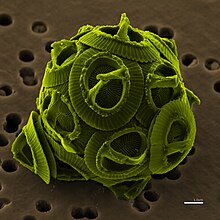하크로비아
Hacrobia| 하크로비아 | |
|---|---|
 | |
| 코콜리토포레 게피로캅사 대양주 | |
| 과학적 분류 | |
| 도메인: | 에우카리오타 |
| (랭킹되지 않음): | 비콘타 |
| (랭킹되지 않음): | 크로말벨라타 |
| 하위 킹덤: | 하크로비아 오카모토 외, 2009년 |
| 무리 | |
| 동의어 해설 | |
| |
크립토모나드-햅틱스 조립체는 SAR 슈퍼그룹에 포함되지 않은 단세포 진핵생물의 단극성 그룹이다[1]. Several alternative names have been used for the group, including Hacrobia (derived from "ha-" referring to Haptophyta, "-cr-" referring to cryptomonads, and "-bia" as a general suffix referring to life);[2] CCTH (standing for Cryptophyta, Centrohelida, Telonemia and Haptophyta);[3] and "Eukaryomonadae".[4]
2012년[update] 2월 현재, 이 집단이 단핵성인지 아닌지는 불분명하다; 계통생성 연구의 결과는 "종종 택사와 유전자 데이터 집합의 선택에 달려 있다".[3] 2012년 두 연구 결과는 정반대였다.[3][5]
회원들
과거에, 헤테로콘트, 햅트로필트, 크립토모나드 등은 크로미스트라고 알려진 그룹으로 함께 분류되기도 했다.[6] 비록 지금은 이단어가 분리되어 있지만, 일부 연구에서는 크립토피타와 합토피타는 밀접하게 연관되어[7][8] 있는 것으로 간주된다(그리고 때로는 단순히 "크립토피타+합토피타" 집단으로 언급되기도 한다).[9] 2009년 논문은 텔로니아와 센트로헬리드들이 그 암호생물과 합심할 수 있다고 제안했다.[10] 피코빌리피테스는 이 그룹에 속할 수 있지만 너무 잘 알려져 있지 않아 자신 있게 분류할 수 없다.[2]
최근 몇 가지 연구들은 햅토피타와 크립토피타가 단층집단을 형성하지 않는다는 결론을 내렸다.[11] 전자는 SAR 그룹의 자매그룹으로, 후자는 아르케아플라스티다(넓은 의미의 플랜트)를 가진 성단이다.[5] 2012년[update] 2월 현재, 하크로비아가 단층집단을 형성하는지는 여전히 불분명하다.[3]
또 다른 연구는[12] 다음과 같은 배열을 제안했다: 센트로헬리드는 합태생물과 밀랍티스타를 형성하고, 햅티스타는 SAR의 자매집단이고, 크립티스타는 고고플라스티다와 관련이 있고, 헵티스타 + SAR은 크립티스타 + 고크로플라스티다와 자매결연이다.
필로제니
실라르 2016년 작업을 기준으로 한다.[13][14]
| 하크로비아 |
| ||||||||||||||||||||||||||||||||||||||||||||||||||||||||||||||||||
참조
- ^ Sakaguchi M, Takishita K, Matsumoto T, Hashimoto T, Inagaki Y (July 2009). "Tracing back EFL gene evolution in the cryptomonads-haptophytes assemblage: separate origins of EFL genes in haptophytes, photosynthetic cryptomonads, and goniomonads". Gene. 441 (1–2): 126–31. doi:10.1016/j.gene.2008.05.010. PMID 18585873.
- ^ a b Okamoto, N.; Chantangsi, C.; Horák, A.; Leander, B.; Keeling, P.; Stajich, J. E. (2009). Stajich, Jason E. (ed.). "Molecular Phylogeny and Description of the Novel Katablepharid Roombia truncata gen. et sp. nov., and Establishment of the Hacrobia Taxon nov". PLOS ONE. 4 (9): e7080. Bibcode:2009PLoSO...4.7080O. doi:10.1371/journal.pone.0007080. PMC 2741603. PMID 19759916.
- ^ a b c d Zhao, Sen; Burki, Fabien; Bråte, Jon; Keeling, Patrick J.; Klaveness, Dag; Shalchian-Tabrizi, Kamran (2012). "Collodictyon—An Ancient Lineage in the Tree of Eukaryotes". Molecular Biology and Evolution. 29 (6): 1557–68. doi:10.1093/molbev/mss001. PMC 3351787. PMID 22319147.
- ^ "EUKARYOMONADAE". Retrieved 2015-03-01.
- ^ a b Burki, F.; Okamoto, N.; Pombert, J.F. & Keeling, P.J. (2012). "The evolutionary history of haptophytes and cryptophytes: phylogenomic evidence for separate origins". Proc. Biol. Sci. 279 (1736): 2246–54. doi:10.1098/rspb.2011.2301. PMC 3321700. PMID 22298847.
- ^ Csurös M, Rogozin IB, Koonin EV (May 2008). "Extremely intron-rich genes in the alveolate ancestors inferred with a flexible maximum-likelihood approach". Mol. Biol. Evol. 25 (5): 903–11. doi:10.1093/molbev/msn039. PMID 18296415.
- ^ Rice DW, Palmer JD (2006). "An exceptional horizontal gene transfer in plastids: gene replacement by a distant bacterial paralog and evidence that haptophyte and cryptophyte plastids are sisters". BMC Biol. 4: 31. doi:10.1186/1741-7007-4-31. PMC 1570145. PMID 16956407.
- ^ Aharon Oren; R. Thane Papke (1 July 2010). Molecular Phylogeny of Microorganisms. Horizon Scientific Press. pp. 190–. ISBN 978-1-904455-67-7. Retrieved 21 January 2011.
- ^ Reeb VC, Peglar MT, Yoon HS, et al. (May 2009). "Interrelationships of chromalveolates within a broadly sampled tree of photosynthetic protists". Mol. Phylogenet. Evol. 53 (1): 202–11. doi:10.1016/j.ympev.2009.04.012. PMID 19398025.
- ^ Burki, F; Inagaki, Y; Bråte, J; Archibald, J; Keeling, P; Cavalier-Smith, T; Sakaguchi, M; Hashimoto, T; Horak, A; Kumar, S; Klaveness, D; Jakobsen, KS; Pawlowski, J; Shalchian-Tabrizi, K (2009). "Large-scale phylogenomic analyses reveal that two enigmatic protist lineages, Telonemia and Centroheliozoa, are related to photosynthetic chromalveolates" (Free full text). Genome Biology and Evolution. 1: 231–8. doi:10.1093/gbe/evp022. PMC 2817417. PMID 20333193.
- ^ Baurain, Denis; Brinkmann, Henner; Petersen, Jörn; Rodríguez-Ezpeleta, Naiara; Stechmann, Alexandra; Demoulin, Vincent; Roger, Andrew J.; Burger, Gertraud; Lang, B. Franz & Philippe, Hervé (2010), "Phylogenomic Evidence for Separate Acquisition of Plastids in Cryptophytes, Haptophytes, and Stramenopiles", Molecular Biology and Evolution, 27 (7): 1698–1709, doi:10.1093/molbev/msq059, PMID 20194427
- ^ Burki, F; Kaplan, M; Tikhonenkov, DV; Zlatogursky, V; Minh, BQ; Radaykina, LV; Smirnov, A; Mylnikov, AP; Keeling, PJ (2016). "Untangling the early diversification of eukaryotes: a phylogenomic study of the evolutionary origins of Centrohelida, Haptophyta and Cryptista". Proc Biol Sci. 283 (1823): 20152802. doi:10.1098/rspb.2015.2802. PMC 4795036. PMID 26817772.
- ^ Silar, Philippe (2016), "Protistes Eucaryotes: Origine, Evolution et Biologie des Microbes Eucaryotes", HAL Archives-ouvertes: 1–462
- ^ Ruggiero; et al. (2015), "Higher Level Classification of All Living Organisms", PLOS ONE, 10 (4): e0119248, Bibcode:2015PLoSO..1019248R, doi:10.1371/journal.pone.0119248, PMC 4418965, PMID 25923521
- ^ Cavalier-Smith, T.; Chao, E. E.; Lewis, R. (17 April 2018), "Multigene phylogeny and cell evolution of chromist infrakingdom Rhizaria: contrasting cell organisation of sister phyla Cercozoa and Retaria", Protoplasma, 255 (5): 1517–1574, doi:10.1007/s00709-018-1241-1, PMC 6133090, PMID 29666938
외부 링크
| 위키피아는 하크로비아와 관련된 정보를 가지고 있다. |


